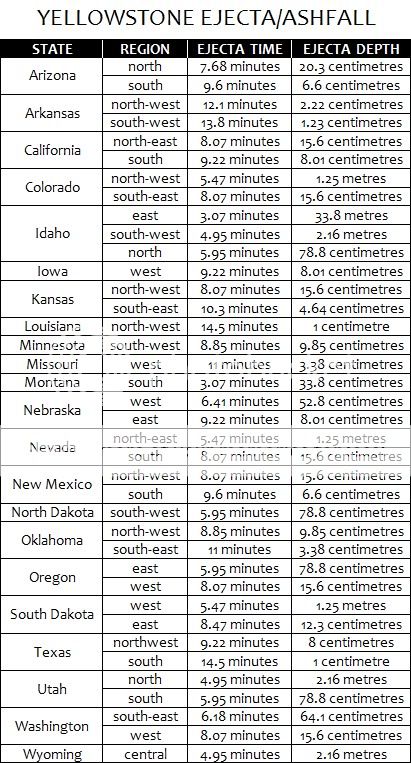It looks like you're using an Ad Blocker.
Please white-list or disable AboveTopSecret.com in your ad-blocking tool.
Thank you.
Some features of ATS will be disabled while you continue to use an ad-blocker.
share:
Originally posted by Sir Solomon
We were discussing this possibility in the office yesterday (with all of the activity caused with Japan we thought there might be a higher possibility of Yellowstone blowing up), and I was wondering if you could provide some details on some of the inputs to the program. What type of rock did you use for the meteor and of the target zone? what size and velocity would give the similar level of energy release?
Projectile Diameter: 2.477 km
Projectile Density: Iron
Impact Velocity: 72 km/s
Impact Angle: 90
Sedimentary Rock
I remember watching a Discovery channel movie on what could happen if Yellowstone did release. If I remember it right it stated the ash wouldn't start falling for an hour or two in the midwest. The downside was that it was much thicker and it fell for a long period of time. I'll see if I can find it online and post a link.
I watched it when it aired, and I did recall that...that's why I was unsure of the results at first. However, considering the similarities between an asteroid impact and a supervolcano explosion, I chose to run with it.
I was also considering that the impact velocity may skew the results a little. I might see if making it a slower speed and a larger size better replicates the ash times shown in the movie (or you can try it). This is certainly a worst case scenario, though.
Originally posted by CLPrime
With the potential for an eruption of the Yellowstone Supervolcano, I thought it might be useful, and possibly beneficial, to show a state-by-state breakdown of what could be expected, given a worst-case-scenario, from the most immediate effect - ashfall.
As far as I know, there are no qualitative predictions of what sort of amounts to expect at given areas, and certainly no predictions of expected times for the arrival of ejecta at those areas. So, in the most accurate way I could find without an actual computer simulation of the event, I used the Imperial College London's asteroid impact effects program (link) to model the ejecta/ashfall that would match all of those maps we've all seen of previous ashfall, and then plugged in different locations to see what the ejecta thickness and arrival times would be. The impact of an asteroid should closely resemble the eruption of a supervolcano (I actually thought about that for a while, and concluded that the two are, in fact, similar enough to compare in this way), so I think this should be an accurate representation.
Now, this fails to take wind and air currents (especially the jetstream) into account, so ejecta thickness should be less to the north/west and more to the south/east, while arrival times should be more to the north/west and less to the south/east. This should give the general idea, though.
In the event of an eruption at Yellowstone, people in the vicinity need the most information possible. And, given that once the supervolcano actually erupts there will be very little to no time to gather that information, it is wise to have it provided, to the best of our knowledge, beforehand.
It's my hope that, if any use is found for this at all, it will help people determine for themselves, beforehand, whether or not it would be safer to evacuate or stay in their homes, given, especially, the arrival times, when the ejecta should first begin to fall. Would you be able to get to relative safety before becoming burdened by the ashfall? Would it be better for you to stay in you home, or wherever you are, and wait it out? These are things that should be considered beforehand, and I hope this helps.
These are the results for ejecta/ashfall arrival times and final thickness for the given regions. Because the regions are general, the numbers given are estimates.
If a region does not appear on the list, it has little chance of being significantly effected by the ashfall. People in these regions are more likely to be dealing with cooling temperatures, failing crops, food shortages, poisoned water, wild and starving animals, and, perhaps worst of all, starving people. Just a heads-up.
Hey just wondering what parameters did you input into the model? thanks
new topics
-
ILLUMINATION: Dimensions / Degrees – Da Vincis Last Supper And The Philosophers Stone
Secret Societies: 4 hours ago -
Just Sick of It! Done! Can't take it anymore!
General Chit Chat: 5 hours ago -
Speaking of Pandemics
General Conspiracies: 7 hours ago -
Stuck Farmer And His Queue Jumping Spawn
Rant: 7 hours ago
top topics
-
Speaking of Pandemics
General Conspiracies: 7 hours ago, 8 flags -
Paradox of Progress
Ancient & Lost Civilizations: 15 hours ago, 7 flags -
ILLUMINATION: Dimensions / Degrees – Da Vincis Last Supper And The Philosophers Stone
Secret Societies: 4 hours ago, 6 flags -
Stuck Farmer And His Queue Jumping Spawn
Rant: 7 hours ago, 4 flags -
Just Sick of It! Done! Can't take it anymore!
General Chit Chat: 5 hours ago, 4 flags


